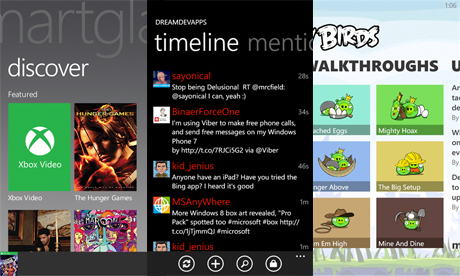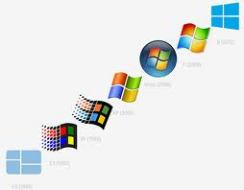Welcome to our relaunched monthly roundup of the best new
Windows Phone apps, just in time for the first Windows Phone 8
smartphones to go on sale from Nokia, Samsung and HTC.
Unlike
our weekly iOS and Android roundups, games are included here, in case
you missed their inclusion in the weekly mobile games posts.
Where
apps and games are exclusive to a particular manufacturer (usually
Nokia), we'll say in the text. It's not always possible to provide a
web-link in these cases, but they're searchable in the handset makers'
on-handset stores.
And why monthly rather than weekly? That's
related to the flow of high-quality apps at the time of writing, but as
momentum picks up for
Microsoft's platform, this post may well go weekly too.
On with October 2012's apps:
About
as essential a download as you can get on Windows Phone, if you also
have an Xbox 360 console. The SmartGlass app is used to control the
console, including TV shows, films and music, navigating the console's
menus without a joypad in sight, as well as typing on the Windows Phone
keyboard. This is just the start too: Microsoft has more plans up its
sleeve to make SmartGlass an inventive way to interact with games.
Nokia
bagged an exclusive on this app from Rovio, which isn't a new Angry
Birds game. Instead, it's a hub for the world of Angry Birds, offering
news, tutorials, photo-sharing features and a place to launch the
separate games from.
With
plenty of fans on other platforms, board game Carcassonne has made the
leap to Windows Phone, courtesy of Microsoft Studios. It sees you
placing tiles with roads, fields, cities and other features, while
trying to dominate your opponents. Xbox functionality is included.
Looking
for an alternative way to access Twitter from your Windows Phone, other
than the default OS features? MeTweets may be worth a look, especially
if you're a heavy user. A slick user interface for newcomers meets lots
of power features below the surface, including scheduled tweets,
embedded photo-viewing and the ability to mute specific users and
sources.
Fashionable
types may enjoy Vogue's official app, which offers a mixture of news,
interviews and photos from celeb-strewn parties for the latest frock
phenomena. It's elegantly done too, fitting neatly into the Windows
Phone UI.
Now
this could be really useful: an app designed for people switching from
other smartphones to Windows Phone, which promises to find their
favourite apps on Microsoft's store – or alternatives if the original
isn't yet available. With Microsoft promising that 46 of the 50 most
popular iOS and Android apps will soon be on Windows Phone, and Nokia
making "switch to Lumia" one of its marketing slogans, AppSwitch is
hitting a sweet spot.
This
app ties into read-it-later service Instapaper, although it requires
you to have a paid subscription to the latter before using it. If so,
you can view unread, liked and archived articles, while switching
between different visual themes to display them.
Another
Nokia exclusive, for now at least. This is EA's latest digital version
of war boardgame Risk, letting you play against AI opponents, or up to
five humans in its multiplayer mode. The game is also plumbed into Xbox
Live for leaderboards.
Shoot
'em up Extraction: Project Outbreak won plenty of praise on iOS, but
now it's available on Windows Phone too. Publisher Chillingo has kept
its soldiers-gone-viral plotline and frenetic gameplay intact, while
adding support for Microsoft's Xbox Live community.
Opinions
on BitTorrent's uTorrent filesharing service vary considerably
depending on you you talk to, but note that it's not just for sharing
copyrighted files. So, taking legitimate uses in mind, uTorrent Remote
may be useful for people using uTorrent on their desktop computer. It's a
way to control that from the Windows Phone.
Graham
Haley's Account Tracker app has been very popular on iOS, and its
Windows Phone port is impressive too – properly optimised for
Microsoft's OS and its design principles. You can use the app to track
spending and bank balances, while setting up alerts and bill reminders.
Off-road
racer Cracking Sands is another Xbox Live-enabled game – Microsoft
tends to release one a week – which ditches the idea of vehicle
categories in favour of a great big free-for-all where dirty tactics go
side-by-side with racing skills.
Another
game, this time from Ubisoft, which sees you in the shoes of a "great,
almighty, and very angry deity" picking on a tribe of humans to ensure
they don't get the Tower of Babel built. An interesting spin on the
god-game genre.
This
is another app with the potential to be really useful: it provides
directions to UK car parks, complete with details of how much they
charge. Information is also included on whether they have disabled
spaces, CCTV, electronic payment and public toilets, with a parking
timer feature to help you avoid staying too long. Some early Windows
Phone Marketplace reviews are reporting bugs and inaccurate data, but
that will hopefully improve.
It's
safe to say that this week's Xbox-enabled game is firmly targeted at US
players, attracted by the idea of shooting "the three biggest whitetail
bucks you can find" while being rewarded for "kill distance, impact
location and number of shots for the kill".
Less
gory, but probably still of most interest in the US, is this handy app
providing news, results, stats and live scoreboards from NBA basketball
matches. It pulls in Twitter feeds from various broadcasters, and lets
you create a "Team Tile" for your preferred team.
This
paid app (a free version is also available) focuses on a database of
streaming mixtapes, promising thousands available, and search features
to filter out ones from favourite DJs and producers. Tracks can also be
stored locally on your phone for offline listening.
Another
one for the US, this is an app for finding tickets to music gigs and
sports events, tapping your location to show those nearest to you, while
also filtering by event/artist, venue and date. Tickets can also be
bought on the phone itself.
Nokia
got fashionable for this exclusive Lumia app, from designer L'Wren
Scott. It offers up photos from recent collections, videos of her
fashion shows, behind-the-scenes info and details of stockists around
the world.
Finally,
Tola is an app for browsing the DeviantArt online community of
artworks, browsing categories, checking new additions every day, and
searching for specific works.
That's our selection, but what have
you been enjoying on your Windows Phone in the last month? Post your
recommendations in the comments, or give your views on the apps above if
you've used them.
Source: http://www.guardian.co.uk/technology/appsblog/2012/nov/01/best-windows-phone-apps-october-2012 



















